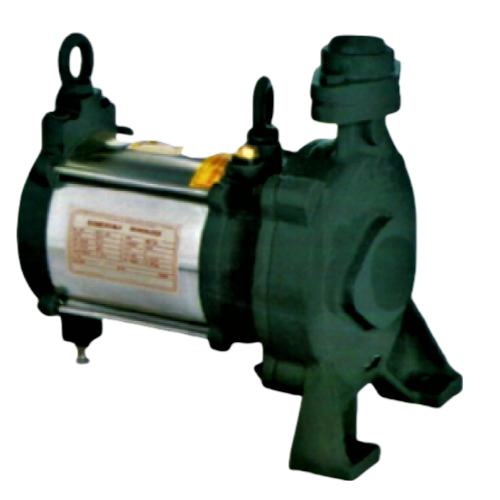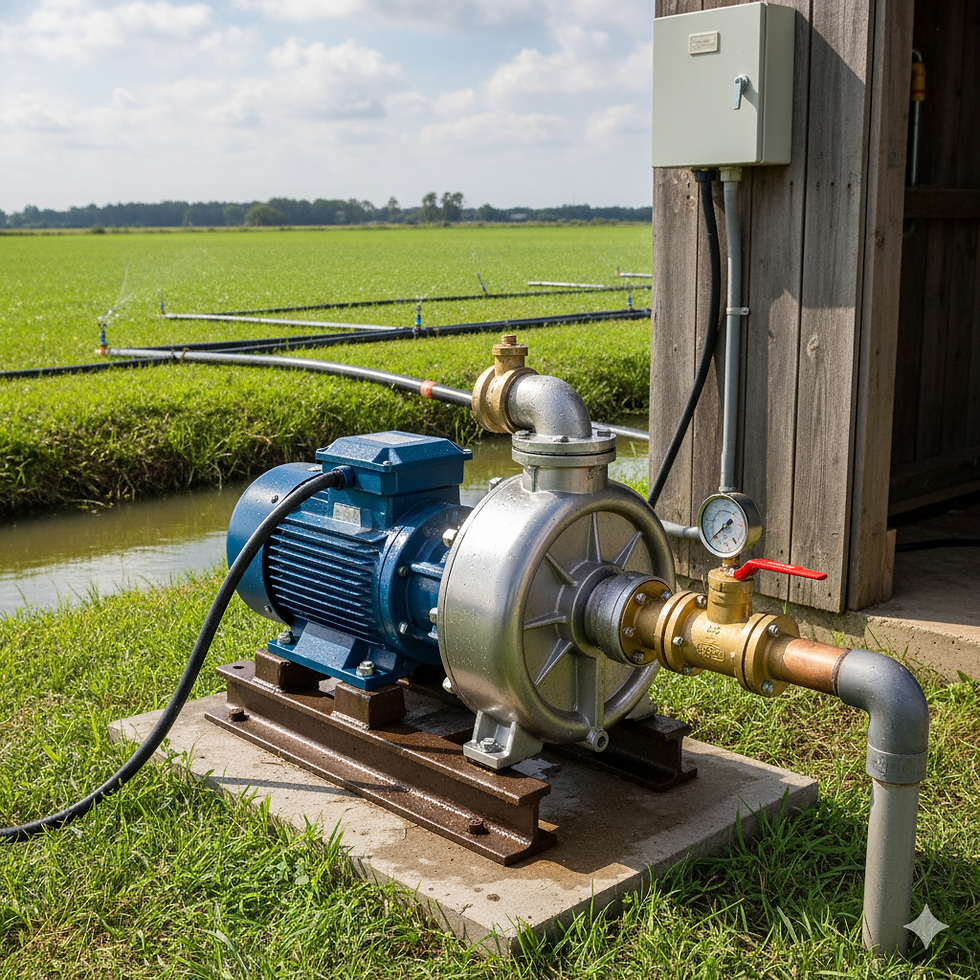Water Pump vs. Booster Pump
- Devaraju HM
- Sep 13
- 6 min read
A Complete Guide to Choosing the Right Solution for Your Needs
When it comes to managing water pressure and flow in your home, garden, or even industrial settings, you'll often encounter two primary terms: water pumps and booster pumps. While both deal with moving water, they serve distinct purposes and are designed for different scenarios. Understanding the difference is key to making an informed decision and ensuring an efficient water system.
This comprehensive guide will break down the functionalities of water pumps and booster pumps, helping you determine which is the best fit for your specific requirements.
What is a Water Pump?
A water pump is a mechanical device designed to move water from one location to another. Its primary function is to lift, transfer, or circulate water, often from a source like a well, reservoir, or storage tank, to a distribution point. They are essential for applications where water needs to be drawn from a lower elevation or moved over a significant distance.

Types of Water Pumps:
Water pumps come in various types, each suited for different applications:
Submersible Pumps: These pumps are designed to be fully submerged in the water they are pumping. They are commonly used for wells, boreholes, and sumps, offering efficient operation and quiet performance.

Jet Pumps: Typically used for shallow wells (up to 25 feet deep), jet pumps are located above ground and use an ejector to create a vacuum that draws water up.

Centrifugal Pumps: These are perhaps the most common type, using a rotating impeller to increase the velocity of water, pushing it outwards. They are versatile and used in many applications, from irrigation to industrial processes.

Common Applications of Water Pumps:
Drawing water from wells or boreholes: Providing water for homes, farms, or commercial buildings where municipal water isn't available.
Irrigation systems: Supplying water to crops, gardens, and lawns.
Draining flooded areas: Removing unwanted water from basements, construction sites, or ponds.
Water transfer: Moving large volumes of water between tanks, reservoirs, or other storage facilities.
What is a Booster Pump?
A booster pump, as its name suggests, is designed to boost or increase the existing water pressure and flow rate within a system. It doesn't typically draw water from a source but rather takes already supplied water and adds more force to it. This is particularly useful when the incoming water pressure is insufficient for your needs, leading to weak showers, slow-filling appliances, or inadequate irrigation.

How a Booster Pump Works:
Booster pumps typically feature an impeller that spins rapidly, drawing water into the pump and then pushing it out at a higher pressure. Many modern booster pumps are equipped with pressure sensors and variable speed drives, allowing them to adjust their operation based on demand, thus saving energy.

Common Applications of Booster Pumps:
Improving household water pressure: Ensuring strong showers, efficient dishwashers, and simultaneous use of multiple fixtures without a drop in pressure.
Commercial and industrial buildings: Maintaining consistent water pressure across multiple floors or for specialized equipment.
Irrigation systems with low main pressure: Ensuring sprinklers and drip systems receive adequate pressure for optimal performance.
Rainwater harvesting systems: Increasing pressure from a storage tank to distribute water throughout a property.
Water Pump vs. Booster Pump: Key Differences
FeatureWater PumpBooster Pump Primary Function Moves water from a source to a destinationIncreases existing water pressure and flow Input Water Draws from a primary source (well, tank, reservoir)Takes water from an already pressurized line Pressure Creates initial pressure to move waterAdds to and amplifies existing pressure Purpose Water acquisition and transferPressure enhancement and flow optimization Common Use Wells, irrigation, drainage, bulk water transferBoosting household pressure, multi-story buildings
Water Pump vs. Booster Pump: A Complete Guide to Choosing the Right Solution for Your Needs
When it comes to managing water pressure and flow in your home, garden, or even industrial settings, you'll often encounter two primary terms: water pumps and booster pumps. While both deal with moving water, they serve distinct purposes and are designed for different scenarios. Understanding the difference is key to making an informed decision and ensuring an efficient water system.
This comprehensive guide will break down the functionalities of water pumps and booster pumps, helping you determine which is the best fit for your specific requirements.
What is a Water Pump?
A water pump is a mechanical device designed to move water from one location to another. Its primary function is to lift, transfer, or circulate water, often from a source like a well, reservoir, or storage tank, to a distribution point. They are essential for applications where water needs to be drawn from a lower elevation or moved over a significant distance.
Types of Water Pumps:
Water pumps come in various types, each suited for different applications:
Submersible Pumps: These pumps are designed to be fully submerged in the water they are pumping. They are commonly used for wells, boreholes, and sumps, offering efficient operation and quiet performance.
Jet Pumps: Typically used for shallow wells (up to 25 feet deep), jet pumps are located above ground and use an ejector to create a vacuum that draws water up.
Centrifugal Pumps: These are perhaps the most common type, using a rotating impeller to increase the velocity of water, pushing it outwards. They are versatile and used in many applications, from irrigation to industrial processes.
Common Applications of Water Pumps:
Drawing water from wells or boreholes: Providing water for homes, farms, or commercial buildings where municipal water isn't available.
Irrigation systems: Supplying water to crops, gardens, and lawns.
Draining flooded areas: Removing unwanted water from basements, construction sites, or ponds.
Water transfer: Moving large volumes of water between tanks, reservoirs, or other storage facilities.
What is a Booster Pump?
A booster pump, as its name suggests, is designed to boost or increase the existing water pressure and flow rate within a system. It doesn't typically draw water from a source but rather takes already supplied water and adds more force to it. This is particularly useful when the incoming water pressure is insufficient for your needs, leading to weak showers, slow-filling appliances, or inadequate irrigation.
How a Booster Pump Works:
Booster pumps typically feature an impeller that spins rapidly, drawing water into the pump and then pushing it out at a higher pressure. Many modern booster pumps are equipped with pressure sensors and variable speed drives, allowing them to adjust their operation based on demand, thus saving energy.
Common Applications of Booster Pumps:
Improving household water pressure: Ensuring strong showers, efficient dishwashers, and simultaneous use of multiple fixtures without a drop in pressure.
Commercial and industrial buildings: Maintaining consistent water pressure across multiple floors or for specialized equipment.
Irrigation systems with low main pressure: Ensuring sprinklers and drip systems receive adequate pressure for optimal performance.
Rainwater harvesting systems: Increasing pressure from a storage tank to distribute water throughout a property.
Water Pump vs. Booster Pump: Key Differences
To summarize, here's a table highlighting the fundamental distinctions:
Feature | Water Pump | Booster Pump |
Primary Function | Moves water from a source to a destination | Increases existing water pressure and flow |
Input Water | Draws from a primary source (well, tank, reservoir) | Takes water from an already pressurized line |
Pressure | Creates initial pressure to move water | Adds to and amplifies existing pressure |
Purpose | Water acquisition and transfer | Pressure enhancement and flow optimization |
Common Use | Wells, irrigation, drainage, bulk water transfer | Boosting household pressure, multi-story buildings |
Which One Do You Need?
Choosing between a water pump and a booster pump boils down to diagnosing your specific water-related problem:
You need a Water Pump if:
You are drawing water from a well, bore, or rainwater tank as your primary water source.
You need to transfer water over long distances or lift it to a higher elevation.
You are managing a pond, pool, or basement and need to remove excess water.
You need a Booster Pump if:
You have municipal water supply, but the pressure is consistently low, especially during peak hours.
Your shower pressure is weak, or your appliances fill slowly.
You live in a multi-story home or building, and upper floors experience low water pressure.
Your irrigation system isn't performing effectively due to insufficient pressure.
Combination Systems
In some scenarios, you might need both! For instance, if you rely on a well for your water (requiring a water pump) but then find that the pressure delivered to your home from the well pump isn't strong enough for modern demands, you might install a booster pump after the well pump to increase the pressure within your home's distribution system.
Conclusion
Understanding the distinct roles of water pumps and booster pumps is crucial for maintaining an efficient and reliable water supply. By accurately assessing whether your issue is about moving water or increasing the pressure of existing water, you can select the correct pump for your needs, ensuring optimal performance and water enjoyment throughout your property. When in doubt, consulting with a plumbing professional or pump specialist can provide tailored advice for your unique situation.





Comments